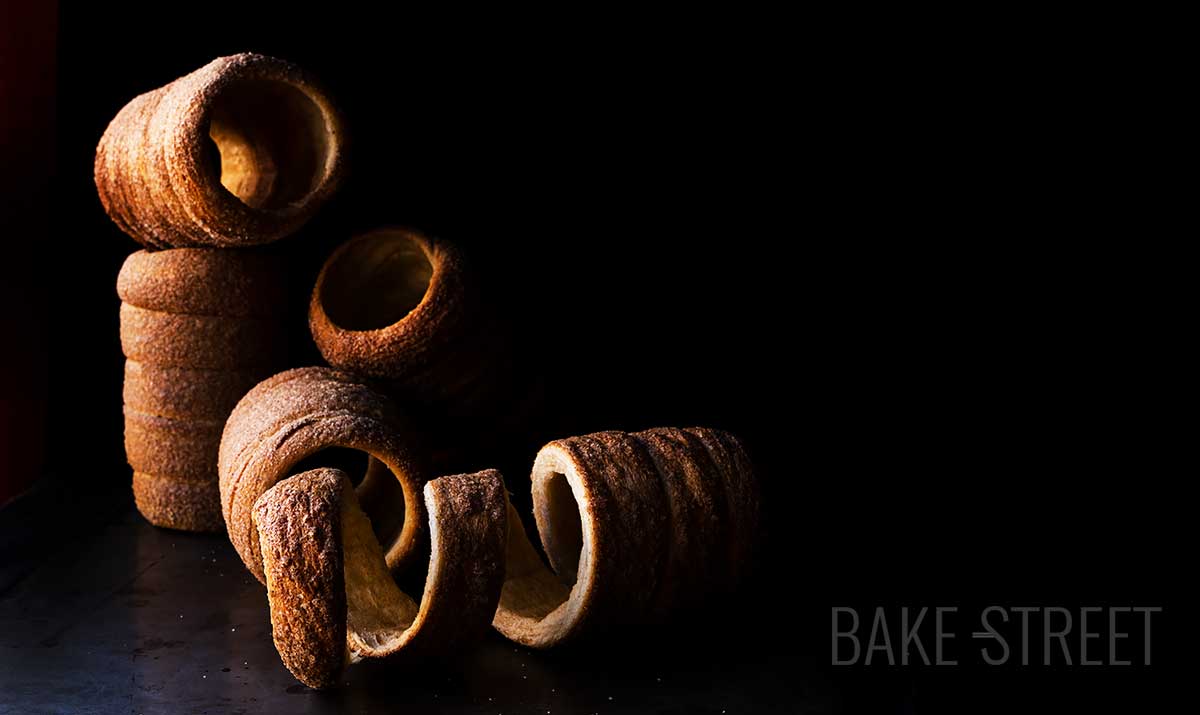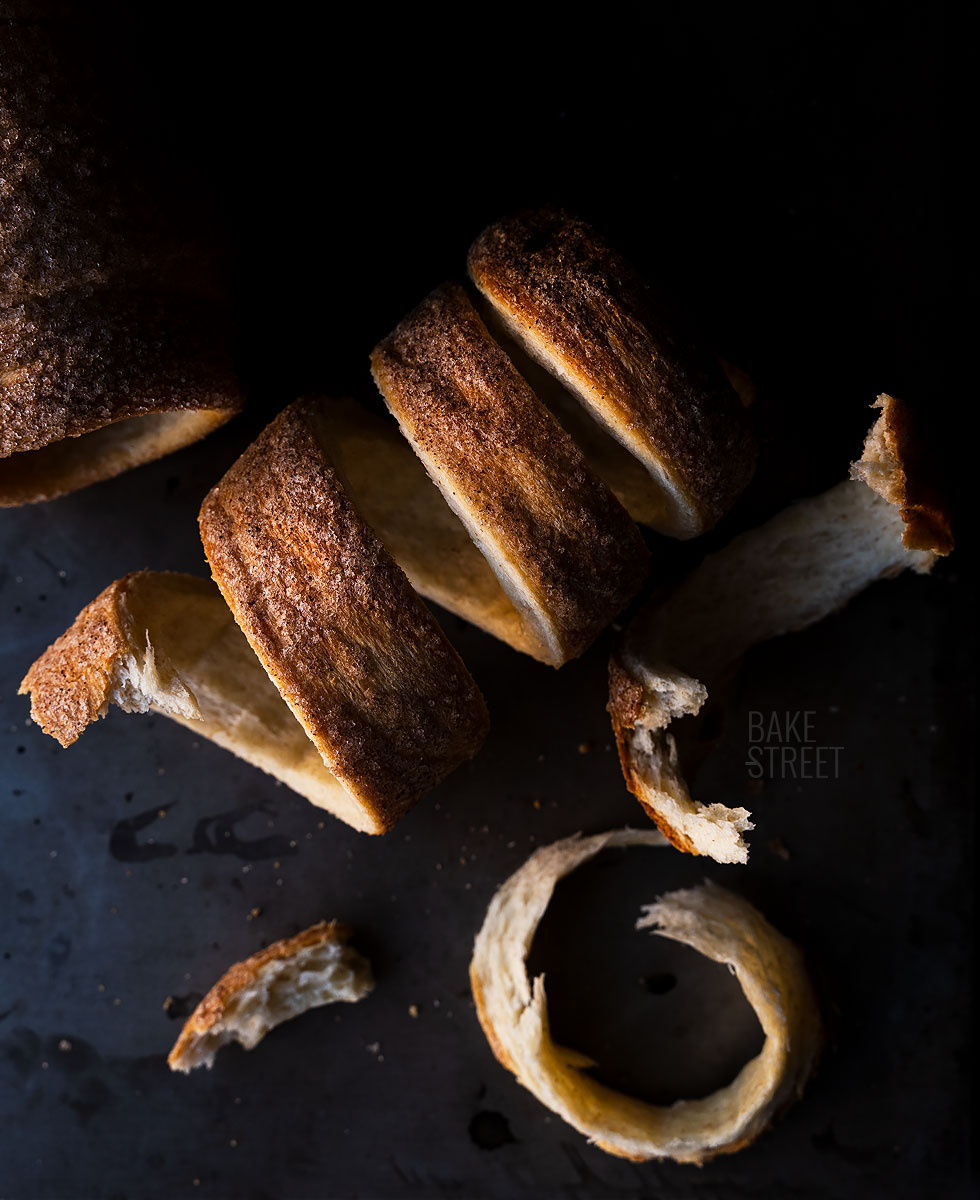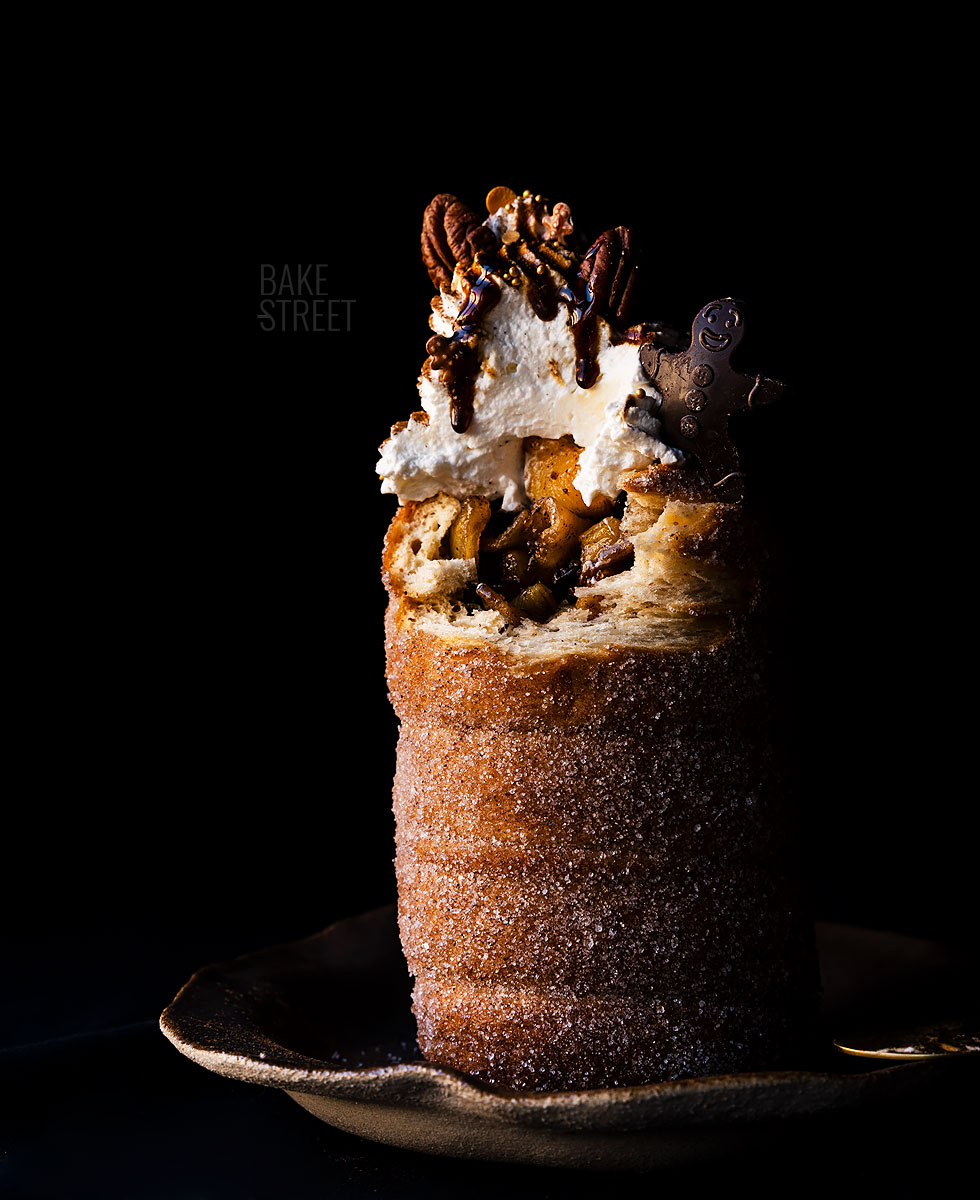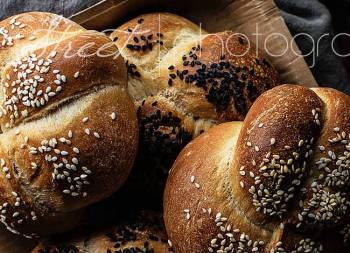
Kürtőskalács, Trdelnik or Trdlo recipe
There are aromas, flavors, recipes that connect us directly to Christmas. A couple of years ago it happened to me with these gingerbread and spiced plum cookies, and this year I had the same feeling with the Kürtőskalács, Trdelnik or Trdlo recipe. Cinnamon is one of those spices that awakens in our unconscious that illusion and joy of these holidays. Along with ginger, it is one of the most used spices in Christmas pastries, so when a space is invaded by this aroma, the connection to this time of year is almost inevitable.
Last year we were on vacation in Prague, where I met this wonderful sweet, but under a different name. There they call them “Trdlo” or “Trdelnik” and it is very common to find them all over the streets. Its aroma floods the alleys, passages… It is wonderful to walk with that special fragrance. Besides that we can find them with infinity of fillings… I don’t know how many I could eat, oh my God!

Kürtőskalács origin.
“Kürtőskalács” [kourtoesch-kaalatsch] is a typical specialty of the Hungarian gastronomy of Transylvania. It was the bakery of the Szeklers, specialized in events like weddings, baptisms… was who created this cake so famous nowadays. In Szeklerland it is still a tradition that is kept alive.
It is a sweet bread made with a leavened dough that is rolled up on a wooden roller to be baked on embers. The outside is brushed with melted butter and covered with a mix of sugar and cinnamon, mostly, but can also be sprinkled with nuts.
Kürtőskalács made in Szeklerland takes its name from the wooden roller on which it is baked which, in this region, is called a chimney and the result of the sweet reminds one of a chimney. The ingenuity of the Szeklers showed that the live coal used for cooking and heating can also be used for something else. They took the embers out of the stove, placed them on the oven, and cooked this sweet bread.
Depending on where we eat it, we can find them under different names:
- Kürtőskalács: Original name, Transylvania. It used to be a typical festive gift made by Hungarians at special events and weddings.
- Chimney Cake: It is usually called this way in English, because of its similarity to a fireplace and because of the difficulty in pronouncing the original name.
- Trdelnik or Trdlo: name of Czech or Slovak origin, under this name we can find them in Prague.
- Kurtosh:is pronounced as it is written, so it is much easier to remember.
- Makara: Brand created in Turkey. Appeared in a popular Turkish drama “Kuzey Guney”.
- Baumstriezel: or “tree cake”, can be found at the German and Austrian Christmas markets along with their famous “Glühwein”.

There are many legends and possible origins of “kürtőskalács”.
The first known record that mentions these cakes baked on a rotating spit over ashes dates from the medieval period (around 1450) and is found in a manuscript from Heidelberg. The description mentions a strip of leavened dough that has to be wound in the form of a spiral around a baking cylinder brushed with egg before baking.
First known recipe originated in Transylvania and was included in the cookbook of Countess Mária Mikes de Zabola in 1784, (“‘kürtős kaláts’ à la Mrs. Poráni”). However, in this recipe, there is no mention of the addition of sugar in its preparation. A recipe from the cookbook written by Kristóf Simai in 1795 in Upper Hungary (today’s Slovakia) mentioned for the first time “post-cooking sweetening”.
But, according to legend, the kürtőskalács existed centuries before and even saved a besieged city from starvation.
The scholar and writer Balázs Orbán recorded the history of the kürtőskalács in his famous work: “Describing Szeklerland“, in 1868. The dessert, he wrote, was created by women in what is today the Székely Land / Szeklerland, the Hungarian-speaking region of Transylvania, during the Mongolian invasion in 1241, “The Marefalva Dodge“.
When the Mongols invaded the countryside, the people of Marefalva retreated to the caves in the hills above the village. The Mongols followed them, but they could not reach the protected area. Instead, they laid siege to the caves in an attempt to starve the Seklers. As the siege continued, both sides began to run out of food. The Seklers knew that the army waiting outside had as few resources as they did, yet the women in the cave devised a plan to fool the invaders.
They took all the leftover flour and mixed it with water and ashes from the chimney to make it look bigger. Then they rolled it up in a long wooden stick and baked it, creating a bread that looked big, but was hollow inside. The Seklers brought the food out of the caves for the enemy to see, essentially saying; “Look how well we still live, while you guys are starving”.
Seeing this, the Mongols saw no other option. They burned the village and left.

Like all legends, it may or may not be true.
There is another one in Europe and it probably goes back to the ancient Greeks. The Hungarian nobility popularized this candy in the 18th century, but it was later reduced during the years when the region was walled by the USSR.
After the fall of the wall, when all of Romania – including the Transylvania region – was opened again to tourists, visitors from Hungary went to the Sekler-Hungarian villages, where the locals sold kürtőskalács. This sweet bread has become the image of Transylvania and the Sekler-Hungarians in Hungary. In the mid-1990s, it was already popular in both countries.
Trdelnik from Szakolca is based on a very similar preparation; the outside is usually covered with chopped nuts before cooking and sugar which is added only after cooking. An extract from “Rézi néni Szakácskönyve” (Aunt Rézi’s Cookbook), published in Szeged, Hungary, in 1876, shares the first recipe in which sugar is added by sprinkling it on kürtőskalács before baking to achieve a caramelized sugar coating.
It was almost 100 years before the next step in the evolution of kürtőskalács was first mentioned.
The appearance of a caramelized sugar coating. Ágnes Zilahi’s cookbook entitled Valódi Magyar szakácskönyv (The Real Hungarian Cookbook), which appeared in Budapest in 1892, presents this recipe.
The first mention of additional coatings applied to the pastry coating appears in the Rézi néni szakácskönyve (Aunt Rézi’s Cookbook). The use of ground, chopped or candied nuts used in the coating only became popular at the end of the 20th century. It seems that Pál Kövi’s cookbook, Erdélyi lakoma (Transylvanian Feast), from 1980, was the first source to use this type of covering. From here on, they started to expand much more; cinnamon, coconut, cocoa
The current and most commonly used variant of kürtőskalács evolved in Szeklerland in the first half of the 20th century.
Unbaked dough, placed around a specific baking cylinder, is flattened (rolling on itself) on a flat surface sprinkled with granulated sugar. In this way, the dough becomes uniform, achieving a much more attractive and elegant finish.
The first written record of this procedure appears in the cookbook of Mrs. Zathureczky, née Manci Zlech, which was published in Barót between 1934 and 1943. The cookbook entitled Erdélyi ízek (Tastes of Transylvania), which appeared in Csíkszereda (Szeklerburg/Miercurea-Ciuc), published by Proprint Press in 2007, details the process of making this recipe in this way.
And that is how I will show you how to make these Trdelnik or Kürtőskalács 😉
Recipe Kürtőskalács
Ingredients for 6 pieces
FOR THE DOUGH:
- 500 g bread flour
- 200 g whole milk
- 45 g sugar
- 3 large eggs
- 70 g unsalted butter at room temperature
- 3 g dry yeast
- 5 g salt
BRUSH AND SPRINKLE:
- 25-30 g unsalted butter, melted and cooled
- sugar and cinnamon to taste
FILLING (Apfelstrudel, for 1 piece):
- 60 g whipped cream (60 g heavy cream, cold + 1/2 Tbsp icing sugar)
- 1 Fuji apple
- 10 g unsalted butter
- 35 g sugar
- raisins to taste
- cinnamon to taste
- pecans, sprinkles y Christmas chocolate
- cinnamon powder to finish
- caramel
Instructions
FIRST DAY
Make the dough for Kürtőskalács.
- Add the flour along with the milk, eggs, yeast and sugar. Mix with the hook at speed 1 until a developed dough is obtained. It will take us a while, that's why it's better to use a dough mixer if you have one.
- Add salt after 7-8 minutes kneading.
- Once we have the gluten developed, incorporate the butter. We will do it in two batches and we will not add the next one until the first one has been completely absorbed.
- The total time of kneading will be around 1 hour with rest times.
Make bulk fermentation.
- Make a ball with the dough and put it in a slightly greased container. Cover and let it rise until it until it grows to 1/3 of its size. In my case it was 3 hours at 70º-71,6ºF/21º-22ºC.
- Store in the fridge overnight. In my case it was 10 hours at 39ºF/4ºC.
SECOND DAY
Shape Kürtőskalács.
- Preheat oven to 365ºF/185ºC.
- Line two rolls with aluminum foil and baking paper, as I show you in the video. To stick the baking paper on itself, we will use some butter. The rollers will be used to bake the Kürtőskalács. Set aside.
- Remove the dough out of the fridge and temper it for 1 and 1/2 hours.
- Dump the dough on a clean work surface and carefully degas it.
- Divide it into 6 pieces of 165 g, approximately.
- Cover with film while stretching the pieces to prevent them from drying out.
- Spread the work surface and our hands with some oil. That way we can stretch and work with the dough without problems. You will notice that it is a dough that adheres a little to the work surface, for that reason we need to grease it to favor the stretching process without tearing it.
- Take one of the pieces and fold it over itself, in the same way that we would shape a baguette.
- Slide both hands over the piece to give it length until it reaches 90 cm.
Place the dough on the roller.
- Place the stretched piece rolled up on the roller, in the video I show you how to do it. We must hold the beginning of the dough with the dough itself when we roll it up. To close the final part, we will introduce the end of the dough under part of the rolled up dough.
- Stretch another piece in the same way as the previous one and place it at the other end.
- Roll over the work surface to unify the thickness of the dough.
- Brush the surface with melted and cooled butter.
- Sprinkle with a mixture of sugar and cinnamon to taste.

Bake.
- Place the roller on a baking dish and put it at medium height.
- Bake for 20-22 minutes turning from time to time to achieve a uniform baking and browning.
- Remove from the oven and let it rest on the rolling pin for 4-5 minutes.
- Remove from the roller and leave to cool on a rack.
- Repeat the same process with the rest of the pieces.
Fill them.
- At this point we can either consume them as they come out of the oven, which are really delicious, or we can fill them to our liking.
- In my case I have stuffed it with a filling that reminds us of the apfelstrudel (I like it very much). If we want to eat it filled, I advise you to leave this one done before baking it.
- To see how to make the apfelstrudel filling, you can see it in the strudel recipe I left you some time ago. In the list of ingredients I have left the amount to fill a Kürtőskalács.
- Fill with the apfelstrudel filling, pipped whipped cream, decorate with pecans, sprinkles, chocolates, cinnamon powder and caramel.
- Enjoy.

Notes
- It is important to achieve a good development of the gluten to obtain a soft and spongy dough.
- The final hydration of the dough, amount of milk, will be conditioned by the strength/capacity of absorption of your flour. If you use a less strong flour, you should reduce the amount of milk to avoid it being too hydrated. I advise you to add it little by little so as not to exceed the final hydration and take into account the amount of butter that will be added later, which will not only enrich it but also affect its final consistency.
- We can sprinkle them with sugar and cinnamon, but we can also use nuts if we wish.
- To bake the Kürtőskalács/Trdelnik we need a utensil that allows us to cook them without them being supported, otherwise this part will be flat. There are some specific molds for this (you can see them in this link), but we can make a homemade arrangement with rollers. In my case I have used two rollers, they are quite long and allow me to cook two pieces at once, but in case yours are smaller you can cook them one by one. To prevent them from getting dark, we will cover them with aluminum foil and, on this, we will put baking paper to place the dough. To bake them, place the rollers on a baking dish, so that the base is not supported. Remember to turn the rollers from time to time to ensure that the dough is cooked evenly over the entire surface.
- If you use rollers like mine, without handles, I advise you to make some marks on the paper to mark the part that rests on the tray. This will help you know from what point you have to place the dough so that when you place the roller on the tray, the dough does not rest on it (and make it lose its shape).
- It is important not to exceed the baking time, otherwise they will be very dry and not as good.
- I advise you to leave the filling prepared in advance, in case you want to consume it this way.
- The ideal is to consume them the same day we make them, but in case we have any leftover, we can keep it in a zip-lock bag. Before consuming it, if we give it a heat stroke in the oven/microwave, it will take again a tender texture.

I can not think of a better plan for these days, especially now that we have a few holidays, to try to make at home these Kürtőskalács - Trdlo - Trdelnik. Whatever we call them, they are incredibly good!
Besides they are very versatile because you can enjoy them as they are or fill them with whatever you like. Whether it is the option I have left you or others that you can think of. What's more, if we smear the inside with chocolate, Nutella®... And we add nuts, they are also incredible.
I wish you a wonderful weekend!
Big hugs,
Eva
Sources: Kurtos Cakes, Vitezkurtos, Matadornetwork





